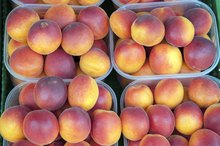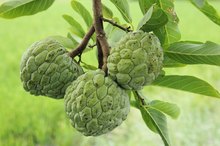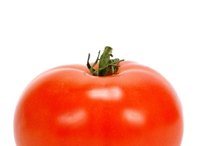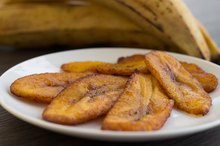How to Freeze Honeydew
Honeydew melon season lasts from summer into the middle of fall, but sales at the market don’t occur all that frequently, and the weight of a ripe honeydew melon can result in a high price. If you’ve been able to get honeydew melons at a substantial discount during a sale, freeze some of them so that you can enjoy the melon later in the year 3.
Procedure
Wash the outside of the honeydew melon and dry it. Slice it into strips that you can bend a little; if you cut them too wide, you’ll have trouble cutting out the edible part of the melon, unless you are using a melon baller. Cut off the edible part, and if you want, cut that into chunks. You can either freeze these as is -- the University of Nevada Cooperative Extension says to freeze them on a cookie sheet first -- or pack them in sugar syrup 23. PickYourOwn.org says the syrup needs to be 30 percent sugar.
- Wash the outside of the honeydew melon and dry it.
- Slice it into strips that you can bend a little; if you cut them too wide, you’ll have trouble cutting out the edible part of the melon, unless you are using a melon baller.
Contamination
How to Freeze Nectarines
Learn More
Any food, including a honeydew melon, can carry germs that can cause food poisoning, either through contamination in the field or from a person handling the melon in the market. If you cut the melon open without washing it, germs on the outside can travel inside along with the knife blade. Do not skip washing the melon.
- Any food, including a honeydew melon, can carry germs that can cause food poisoning, either through contamination in the field or from a person handling the melon in the market.
- If you cut the melon open without washing it, germs on the outside can travel inside along with the knife blade.
Why Freeze Them
Rather than trying to finish off an entire melon within a couple of days, freezing allows you to save some for later without having to worry about it going bad. Honeydew melons don’t last that long once you get them home. If you manage to buy a ripe one -- they won’t ripen on the shelf -- you have only a couple of days to eat it, according to the University of Nevada Cooperative Extension 2.
Considerations
How to Eat Cherimoya
Learn More
Melons are very watery fruits, some more than others. That water can cause the melon’s cells to break when the water inside of them freezes. For very watery melons, like watermelons, this can be a major problem as the flesh essentially collapses when the melon fully thaws. Honeydew melons aren’t as watery, though, so while they won’t become a pile of fruit tissue, they will become soft. Iowa State University Extension advises serving the melons while they are still partly frozen.
- Melons are very watery fruits, some more than others.
- For very watery melons, like watermelons, this can be a major problem as the flesh essentially collapses when the melon fully thaws.
Cautions
Preparing and slicing up a honeydew melon can take some time, but cut up the melon before you freeze it to save yourself trouble later -- just take care when cutting it 3. Just as freezing and thawing can make the flesh of the melon mushy, it can make the rind soft. This will be annoying to try to cut up because if you thaw it completely, it could be too soft for you to make tidy cuts. If you keep it somewhat frozen, it could still be too hard to cut, or it could become slippery, which is a dangerous situation when using a knife.
- Preparing and slicing up a honeydew melon can take some time, but cut up the melon before you freeze it to save yourself trouble later -- just take care when cutting it 3.
- If you keep it somewhat frozen, it could still be too hard to cut, or it could become slippery, which is a dangerous situation when using a knife.
Related Articles
References
- PickYourOwn.org: Freezing Cantaloupes, Honeydew, Watermelons and Other Melons
- University of Nevada Cooperative Extension: Heavenly Honeydew
- Ochef: Can You Freeze Watermelon?
- Ochef: How Much Water is in a Watermelon?
- Melons, honeydew, raw. FoodData Central. U.S. Department of Agriculture. Published April 1, 2019.
- University of Wisconsin Integrative Health. Managing dietary carbohydrates for better health. Updated October 2018.
- Gordon B. How much water do you need?. Academy of Nutrition and Dietetics. Updated March 2020.
- National Institutes of Health Office of Dietary Supplements. Folate fact sheet for health professionals. Updated March 11, 2020.
- Du H, Li L, Bennett D, et al. Fresh fruit consumption in relation to incident diabetes and diabetic vascular complications: A 7-y prospective study of 0.5 million Chinese adults. PLoS Med. 2017;14(4):e1002279. doi:10.1371/journal.pmed.1002279
- National Institutes of Health, Office of Dietary Supplements. Vitamin C fact sheet for health professionals. Updated February 27, 2020.
- Wolfram T. 5 top foods for eye health. Academy of Nutrition and Dietetics. Updated May 11, 2018.
- American Academy of Allergy Asthma and Immunology. Oral allergy syndrome (OAS) or pollen fruit syndrome (PFS).
- Foord K, MacKenzie J. Growing melons in the home garden. University of Minnesota Extension. Updated 2018.
- Brainard D, Heilig G, Manning J. How to grow melons. Michigan State University Extension. Updated May 23, 2016.
Writer Bio
Suzanne S. Wiley is an editor and writer in Southern California. She has been editing since 1989 and began writing in 2009. Wiley received her master's degree from the University of Texas and her work appears on various websites.









